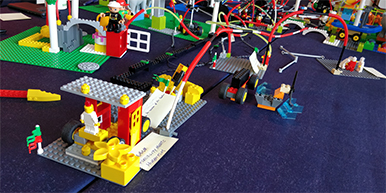
The joys and struggles of growing up
 A few years ago our agency didn’t exist. We were a few freelancers, one of which had a great idea, and a bunch of friends and practitioners who believed in it. Early on we began helping small and large companies in re-thinking their strategy, more specifically their ‘platform strategy’. In a nutshell, we came up with one of the first methodologies to design systems that aims at mobilizing individuals and organisations towards the same strategic lines. This is done by understanding their incentives to join the shared strategy, what they could exchange among each other, and which kind of evolutionary context they’re looking for. Our methodology is known as the ‘Platform Design Toolkit’. Today, our platform design theory is getting thicker as we engage in powerful conversations with an increasing number of practitioners around the world. Heavily based on the reflections we have by working closely with partners and customers, every two weeks we publish on our blog an updated understanding of the most important bits of platform strategies and how they’re radically changing the way we live and work.
A few years ago our agency didn’t exist. We were a few freelancers, one of which had a great idea, and a bunch of friends and practitioners who believed in it. Early on we began helping small and large companies in re-thinking their strategy, more specifically their ‘platform strategy’. In a nutshell, we came up with one of the first methodologies to design systems that aims at mobilizing individuals and organisations towards the same strategic lines. This is done by understanding their incentives to join the shared strategy, what they could exchange among each other, and which kind of evolutionary context they’re looking for. Our methodology is known as the ‘Platform Design Toolkit’. Today, our platform design theory is getting thicker as we engage in powerful conversations with an increasing number of practitioners around the world. Heavily based on the reflections we have by working closely with partners and customers, every two weeks we publish on our blog an updated understanding of the most important bits of platform strategies and how they’re radically changing the way we live and work.
Over the past three years we grew, we shrunk, we grew again. Today we’re a dozen people consolidating a passionate team helping Fortune 500s, SMBs, startups and even institutions like the UN or the NHS. Yesterday everything was the ‘Platform Design Toolkit’ brand, a website, a very small team prototyping a way to do customer work and basically surviving.
Recently, we incorporated a larger team into an italian company named ‘Boundaryless’ with the aim to extend what we do, exploring new ventures and horizons.
As one can imagine it hasn’t been easy, nor is it today. The challenges we had when we were two or three people having one customer per month are radically different from now when we have the whole team constantly busy on a different customer project around the world. How should we spend the money? In which direction should we grow? How do we empower our team more? How can we harmonize the perspectives of founders, investors, and folks that work with us? How do we value the work we do on the governance and operations in respect to customer work? What should this organization be doing when it ‘grows up’? What’s the purpose of this organization?
The underlying central theme to all these questions, and certainly relevant even in our early days is ‘how can we make effective decisions together?’. This is a tough one, especially when you are so fragile as you base all your strategy on a central product with only a few people and resources.

Even before we started our journey with the Platform Design Toolkit, our personal and professional paths crossed with Cocoon Projects and the beautiful humans living and working therein. Thus, our organizational culture has been greatly influenced by LiquidO™ and many other cultural bits that Cocoon Projects has consolidated and spread so far. It is like a sister organization, someone you can always rely upon to clarify your mind when you’re in doubt. Alessandra and Emanuele from Cocoon Projects helped us in a critical summit a few months after we incorporated. With the Cocoon family we even did an amazing customer work together at the UNDP Asia and the Pacific Regional Hub in Bangkok. Every time we do something together we have the kind of excitement shivers that you get when you’re doing something truly meaningful. Deep inside, I guess we both feel this journey together isn’t in any way over, and that the best is yet to come as we both grow up and ‘go to college’ :). On our side, what we learned is that if you’re truly interested in exploring new and better ways of working, you should first learn from others, deeply and with great attention, what they’re doing and how they are doing it. Then you’ll need to experiment, again with great care and humbleness (people can get hurt!). After a while you’ll realize that one recipe works in one context but needs to be amended and adapted to another. That’s what we learned with LiquidO™ and other systems, and indeed that’s what we learned with the Platform Design Toolkit: that context is key.
This article was first published in our Cocooners N° 5





